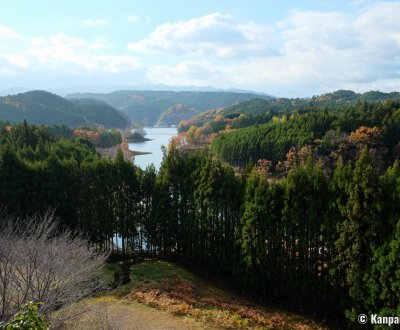Yoshino Forest Therapy
Shinrin-yoku Experience in Nara
The forest therapy is a Japanese medical practice and a well-being experience to discover in Yoshino’s cedar forest, located in Nara prefecture. Through a guided tour in the Japanese countryside, visitors enjoy a replenishing and relaxing walk under the trees in the heart of nature.
Forest bathing, also called forest therapy or shinrin-yoku (森林浴) in Japanese, is an alternative medical practice that grew popular in Japan and also in Europe over the last few years. This therapy acknowledges the trees’ anti-stress properties on people who go walking into the forest. Forest bathing is beneficial for health, both mental and physical. In Japan, where this therapy is ancient, specialists have established several official forest bathing trails throughout the archipelago.
In the heart of Nara prefecture, the small Yoshino City has been trying to revive its touristic attractiveness for several years. The area, renowned for its large natural spaces, is home to a beautiful cedar forest maintained for 400 years. Nowadays, two forest therapy paths are marked and accessible with seasoned Japanese guides:
- Yoshino Miyataki Manyo Course (吉野宮滝万葉コース), a 7,7km mountain hike from Miyataki Ruins on the bank of the Yoshino River to the top of the mountain, a sacred site especially popular in April for its 30,000 blooming cherry trees.
- Shinsenkyo Ryumon no Sato Course (神仙峡龍門の里コース), a 6,6km introductory walk to forest bathing starting around Lake Tsuburo and going through the forest to Ryumon Falls.
The walk described below was on the second path on a day in December.

Easy walk around Lake Tsuburo
Regardless of the chosen trail, the guide will start the tour by a stretching session, to get into condition and get to know the group.
Then, the walk around Lake Tsuburo begins. The trail is rather flat, with views on the lake from almost everywhere. Two suspended bridges cross the body of water and offer a wonderful unobstructed view on the surroundings. There is however a minor inconvenience to this path: it partly takes narrow roads also used by a few cars 🚙. One does not always feel 100% in the nature but the good side of it is that it is accessible to persons with reduced mobility. The tour also winds in the Japanese countryside.
We were surprised to discover a lot of electric fencing surrounding the fields. The locals have recently found that deers and boars tended to leave the mountain and go down to the city to forage for food. The fences are therefore used to prevent them from destroying the farmers’ harvests. According to our guide, the situation is due to several factors:
- The absence of wolf (or of any predator) in the forest;
- September 2018 typhoon Jebi that partly destroyed the natural habitat; and,
- The fact that there are less inhabitants in town, and consequently dogs that could chase away wild animals.
The phenomenon is not specific to Yoshino, but happens everywhere in the Kansai area, and especially in Ohara, in the north of Kyoto.

Immersion in Yoshino Forest on the mountainside
Our preference goes to the second half of the trail that goes deep in the forest on the side of Mount Ryumon-dake. The climb starts at the lovely small Yoshinoyamaguchi shrine dating back to the 7th century. Its delicate roof was made with cypress bark.
Then, the path winds through Yoshino forest centuries’ old cedar trees for a complete immersion in nature. The forest therapy takes it full dimension and the five senses are awakened:
- Touch, by feeling the differences between the trees’ trunks and the grounds on which we walk,
- Vision, by enjoying the sun rays sifting through the foliage and watching the leaves quivering with the wind;
- Smell, by trying to identify the scents from the various vegetal species. We did notice that smells could be greatly different depending on the places where we stopped;
- Hearing, by listening to the birds’ chirping, the whisper of the wind or the rustling of our steps in the fallen leaves;
- Taste, thanks to a delicious bento 🍱 for lunch followed by a tea and its little pastries for the afternoon snack.
Japanese gastronomy does indeed have an important role in practicing the shinrin-yoku, so much that our guide kept the keys of a little shed where were stored a couple of chairs and utensils necessary to prepare tea.
At the same place, there were free-to-use hammocks hanged between the trees. It was for us the best experience of the tour: laying down on a hammock in the heart of the forest and feeling in harmony with the surrounding nature. Lastly, the walk ends at the Ryumon Falls, where it is recommend to stop for a moment of meditation. Nearby, the ruins of an old temple and its pagoda can be visited.
The effect of the forest bathing is immediate on both the body and the mind, and the day ends much more relaxed than it began. Moreover, this feeling of well-being continues on the following days, with a global sensation of serenity, and a proved effect on lowering of the heart rate and blood pressure, to our surprise.
---
Summer is a good season to practice the tree therapy in Yoshino Forest. Under the shade of the trees, the average temperature is 25°C, compared to more than 30°C in the city. This unusual experience in a place off the touristic beaten tracks constitutes a beautiful encounter with nature and those who acknowledge its benefits.

